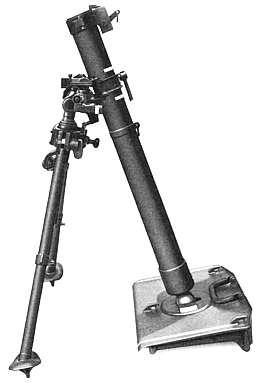8 cm Granatwerfer 34
History, technical sheet and photo

Granatwerfer 34 mortar history
Designed by Rheinmetall in 1932 to increase the firepower of the German infantry with new 8,1 cm mortars, the 8 cm Granatwerfer 34 entered service in 1934. 117 kg of raw materials are needed for its production and the unit price of this mortar comes to 810 Reichsmarck.
Precise and simple to use, it comes in three transportable loads on the back of a man: a base plate all-round, a bipod and a tube with smooth core. Two versions of the Granatwerfer 34 are also developed: a short version (Kurzer 8 cm Granatwerfer 42) and an embedded version (GrW 34/1) for equipping vehicles or defensive positions such as tobrouks, which is the case along of the Atlantic Wall and particularly in Normandy.
The GrW 34 is capable of firing explosive shells and smoke bombs up to one kilometer. The maximum firing distance can be up to 2,400 meters with the addition of propellant charges at the tail fin (three maximum).
At the beginning of the Second World War the German Army had 4,624 GrW 34. From 1939 to 1945, 71,630 were produced.
Granatwerfer 34 mortar specification
Creator/User: Germany
Dénomination : 8 cm Granatwerfer 34 – GrW 34
Production : 1934-1945
Number produced: 71,630 (from 1939 to 1945)
Caliber: 8,14 cm
Maximum firing range: 2,400 m
Maximum rate of fire: 15-25 rounds/min
Total weight: 62 kg
Barrel length: 114,3 cm
Muzzle speed: 174 m/s
Traverse: 360°
Elevation: + 45° to + 90°
Shell payload: 3,5 kg
